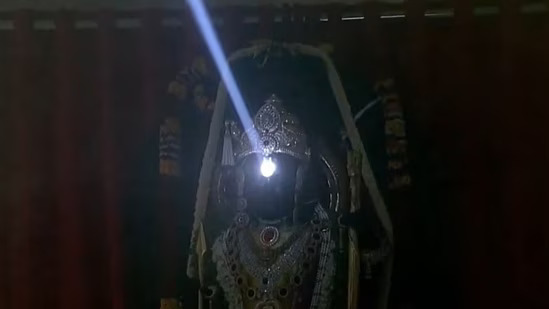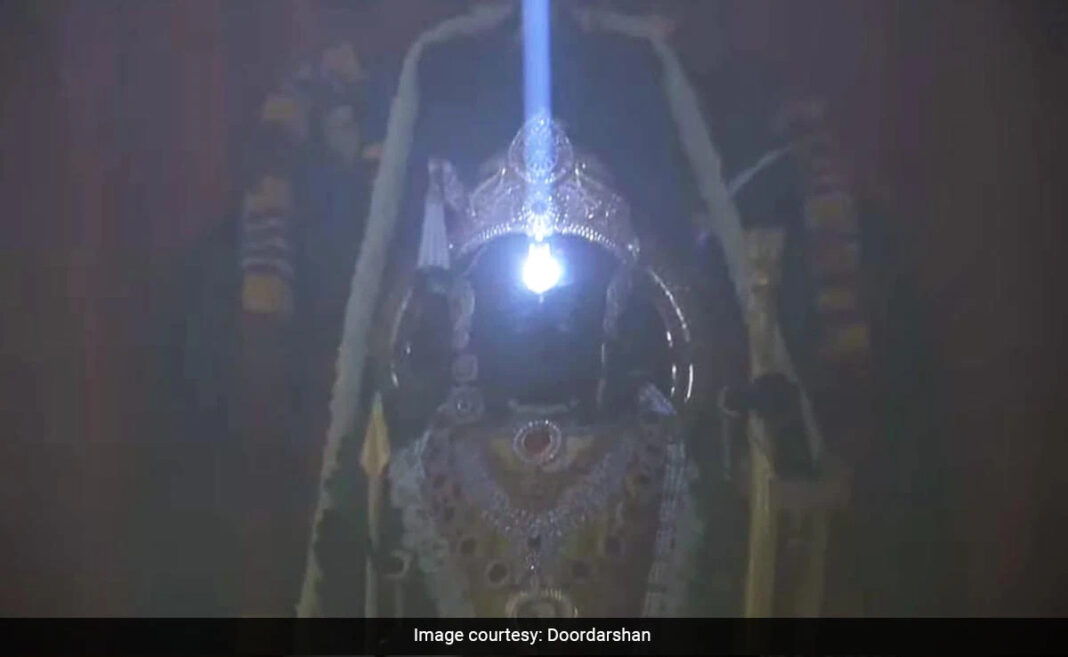In a remarkable display of scientific and engineering prowess, the forehead of the Ram Lalla idol at the grand Ram Temple in Ayodhya was anointed with a precise beam of sunlight during the Ram Navami celebrations today. This unique ritual, known as the “Surya Tilak”, was achieved through the collaborative efforts of a team of esteemed Indian scientists and engineers.

At precisely 12 noon, a 5.8 centimeter beam of light from the sun struck the deity’s forehead, marking a historic moment for the auspicious Hindu festival. This extraordinary feat was the result of months of meticulous planning and the application of cutting-edge scientific expertise.
“The successful execution of the Surya Tilak ritual on Ram Navami is a testament to the prowess of Indian science and engineering,” said Dr. Pradeep Chauhan, a scientist from the Central Building Research Institute (CBRI) in Roorkee who was part of the project team. “It represents a remarkable integration of traditional spiritual practices and modern technological advancements.”
The specialized “Surya Tilak mechanism” designed for this event is a marvel of opto-mechanical engineering. Consisting of a complex arrangement of mirrors and lenses, the system was meticulously engineered to precisely direct the sun’s rays onto the forehead of the Ram Lalla idol.
“The opto-mechanical system includes four mirrors and four lenses fitted inside a tilt mechanism and piping system,” explained Dr. Ramacharla, a key member of the project team. “The complete setup is placed at the top floor of the temple, allowing us to divert the sun’s rays through the mirrors and lenses to the inner sanctum, or Garbha Griha, where the idol is located.”
The final lens and mirror in the system focus the sun’s rays onto the forehead of the Ram Lalla statue, which faces eastward. A specialized tilt mechanism is used to adjust the first mirror’s angle, ensuring the sun’s rays are directed towards the north and ultimately reach the idol’s forehead.
“All the piping and other components are manufactured using brass material, and the mirrors and lenses are of the highest quality to ensure durability and longevity,” added Dr. Ramacharla. “We’ve also incorporated an infrared filter glass at the top aperture to restrict the sun’s heat waves from directly impacting the idol.”
The development of the Surya Tilak mechanism involved a collaborative effort between scientists from the CBRI, Roorkee, and the renowned Indian Institute of Astrophysics (IIAP) in Bengaluru. This partnership combined expertise in solar tracking, positional astronomy, and precision engineering to create the intricate system.
“We possess the requisite expertise in positional astronomy at the Indian Institute of Astrophysics,” said Dr. Annapurni Subramaniam, the Director of IIAP. “This knowledge was instrumental in ensuring that the sun’s rays could ceremoniously anoint the idol of Ram Lalla on every Ram Navami, reconciling the differences between the lunar and solar calendars.”
The team from CSIR-CBRI, led by Dr. SK Panigrahi, Dr. RS Bisht, Mr. Kanti Solanki, Mr. V. Chakradhar, Mr. Dinesh, and Mr. Sameer, worked tirelessly to bring the Surya Tilak mechanism to life. The project was mentored by Prof. R. Pradeep Kumar, the Director of CSIR-CBRI.
From the IIAP in Bengaluru, Dr. Annapurni S., Director of IIA, Er S Sriram, and Professor Tushar Prabhu provided valuable consultations throughout the development process. The manufacturing expertise of Optica, a Bengaluru-based company, also played a crucial role in the execution and installation of the system.
“The Surya Tilak mechanism is a remarkable achievement that seamlessly integrates scientific principles with the spiritual traditions of our country,” said Champat Rai, the General Secretary of the Shri Ram Janmabhoomi Teerth Kshetra Trust, which commissioned the project. “It is a testament to the ingenuity and dedication of our scientists and engineers, who have truly elevated this auspicious ritual to a new level.”
Interestingly, similar Surya Tilak mechanisms have been employed in some Jain temples and the famous Sun Temple at Konark, but the approach and engineering behind the Ram Temple’s system are unique.
“What sets the Ram Temple’s Surya Tilak mechanism apart is the level of precision and automation involved,” explained Dr. Chauhan. “The intricate arrangement of mirrors and lenses, coupled with the sophisticated tilt mechanism, ensures that the sun’s rays are directed with pinpoint accuracy onto the idol’s forehead, all without relying on electricity, batteries, or iron-based components.”
The successful implementation of the Surya Tilak ritual on Ram Navami is a remarkable achievement that not only showcases India’s scientific and engineering prowess but also highlights the deep-rooted connection between spirituality and technology in the country’s rich cultural heritage.
As devotees gathered at the Ram Temple to witness this historic event, the precise beam of sunlight striking the deity’s forehead resonated with a sense of reverence and awe, leaving an indelible mark on the celebrations and the hearts of all present.
“This is a truly remarkable day for Ayodhya and the entire Hindu community,” said Mahant Nritya Gopal Das, the Chairman of the Shri Ram Janmabhoomi Teerth Kshetra Trust. “The successful execution of the Surya Tilak ritual is a testament to the ingenuity of our scientists and the unwavering dedication of all those involved in this project. It is a proud moment for India, and we are honored to witness this historic event.”
As the sun’s rays slowly retreated from the deity’s forehead, the participants and onlookers were left in a state of profound reverence, aware that they had witnessed a unique confluence of science, engineering, and spirituality – a testament to India’s unparalleled capabilities and the enduring spirit of its people.





